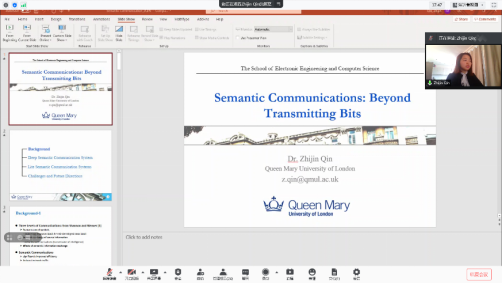On the afternoon of June 8, 2021, Assistant Professor Qin Zhijin of Queen Mary University gave an online academic lecture entitled "semantic Communications: beyond transmitting bits" for teachers and students of our school. The lecture report was presided over by Associate Professor Fu Shu of the School of Microelectronics and Communication Engineering, with the participation of Professor Zhou Xichuan, Associate Professor Zhong Yuanhong, Associate Professor Xu Weiyang and other teachers and students.
Professor Qin Zhijin is an assistant professor at Queen Mary University in UK. From 2016 to 2018, she worked as a lecturer and research assistant at Lancaster University and Imperial College of technology, respectively. Her research interests include semantic communication, compressed sensing and low-power Wan supporting lot applications. She is the field editor of IEEE JSAC series on machine learning in communications and networks and the associate editor of IEEE Transactions on communications, IEEE Transactions on cognitive communications and networking and IEEE communications letters. She was co-chair of IEEE VTC fall 2019 and Globecom 2020, 2021 workshops. She won the best paper award of TEEE globe in 2017 and the best paper award of young author of IEEE signal processing association in 2018.

In the lecture, Professor Qin Zhijin took the system capacity of the communication scheme measured by bits in the past few decades as the starting point, and proposed that inspired by the powerful deep learning technology, semantic communication is a promising solution to further improve the system efficiency, which is considered by Shannon and Weaver as the second level of communication. Professor Qin Zhijin first introduced the concept of semantic communication and its key differences from typical communication, and pointed out that the purpose of semantic communication is to achieve successful semantic information exchange, rather than accurately receive the transmitted bit sequence or symbol. Then, Professor Qin Zhijin introduced the deep learning based semantic communication system deepsc proposed in recent related work in detail, pointing out that deepsc can maximize the system capacity and minimize semantic errors by recovering the meaning of sentences rather than finding bit or symbol errors in traditional communication. In addition, transfer learning can be used to ensure that deepsc is suitable for different communication environments and accelerate the model training process. At the end of the lecture, Professor Qin Zhijin had extensive exchanges with Professor Zhou Xichuan and other teachers and students from the perspective of hardware support of semantic communication, and answered and discussed the questions raised by the audience on the application scope of semantic communication and transmission error correction mechanism.